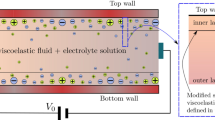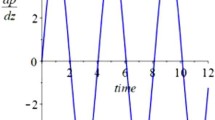Abstract
Perturbation solutions for the velocity and electric potential of a time periodic magnetohydrodynamic slip flow in a microchannel with sinusoidal wall corrugations are obtained using perturbation method. The effects of wall corrugations, slip length, Hartmann number and the frequency of the electric potential on the flow are analyzed theoretically and graphically. The results show that velocity and electric potential are significantly disturbed by wall roughness and that there exists a phase lag between the velocity and the electric potential. The velocity profile is characterized by the ratio of momentum diffusion time scale to the period of the applied electric field. The phase lag increases with frequency, slip length and decreases with Hartmann number, the wavenumber and phase difference of the wall corrugations. However, for a sufficiently small frequency, the phase lag is almost nonexistent. The effect of the phase difference of the wall corrugations on the phase lag becomes unimportant when the wavenumber is larger than 2. The velocity amplitude increases with slip length and decreases with frequency, wavenumber and phase difference. However, the phase difference becomes unimportant for sufficiently large wavenumber. When the frequency is large enough, the velocity amplitude is not influenced by slip length.






Similar content being viewed by others
References
Abdullah M, Duwairi HM (2008) Thermal and flow analysis of two-dimensional fully developed flow in an AC magneto-hydrodynamic micropump. Microsyst Technol 14(8):1117–1123
Akyildiz FT, Siginer DA (2011) Fully developed laminar slip and no-slip flow in rough microtubes. Z Angew Math Phys (ZAMP) 62(4):741–748
Andrade JS, Henriquea EAA, Almeidaa MP, Costa MHAS (2004) Heat transport through rough channels. Phys A 339:296–310
Buren M, Jian Y (2015) Electromagnetohydrodynamic (EMHD) flow between two transversely wavy microparallel plates. Electrophoresis 36(14):1539–1548
Buren M, Jian Y, Chang L (2014) Electromagnetohydrodynamic flow through a microparallel channel with corrugated walls. J Phys D Appl Phys 47(42):425501
Chen CK, Cho CC (2007) Electrokinetically-driven flow mixing in microchannels with wavy surface. J Colloid Interf Sci 312(2):470–480
Chu WKH (1996) Stokes slip flow between corrugated walls. Z Angew Math Phys (ZAMP) 47(4):591–599
Chun MS, Lee S (2005) Flow imaging of dilute colloidal suspension in PDMS-based microfluidic chip using fluorescence microscopy. Colloids Surfaces A Physicochem Eng Aspects 267(1):86–94
Davidson PA (2001) An introduction to magnetohydrodynamics. Cambridge University Press, Cambridge, UK
Duwairi H, Abdullah M (2007) Thermal and flow analysis of a magneto-hydrodynamic micropump. Microsyst Technol 13(1):33–39
Eijkel JCT, Dalton C, Hayden CJ, Burt JPH, Manz A (2003) A circular ac magnetohydrodynamic micropump for chromatographic applications. Sensor Actuat B: Chem 92(1):215–221
Erickson D, Li D (2003) Analysis of alternating current electroosmotic flows in a rectangular microchannel. Langmuir 19(13):5421–5430
Ibáñez G, Cuevas S, de Haro ML (2002) Optimization analysis of an alternate magnetohydrodynamic generator. Energ Convers Manage 43(14):1757–1771
Jang J, Lee SS (2000) Theoretical and experimental study of MHD (magnetohydrodynamic) micropump. Sensor Actuat A Phys 80(1):84–89
Kiyasatfar M, Pourmahmoud N (2016) Laminar MHD flow and heat transfer of power-law fluids in square microchannels. Int J Therm Sci 99:26–35
Laser DJ, Santiago JG (2004) A review of micropumps. J Micromech Microeng 14(6):R35–R64
Leal LG (2007) Advanced transport phenomena: fluid mechanics and convective transport processes. Cambridge University Press, UK
Lemoff AV, Lee AP (2000) An AC magnetohydrodynamic micropump. Sensor Actuat B: Chem. 63(3):178–185
Lemoff AV, Lee AP (2003) An AC magnetohydrodynamic microfluidic switch for micro total analysis systems. Biomed Microdevices 5(1):55–60
Li L, Mo J, Li Z (2014) Flow and slip transition in nanochannels. Phys Rev E 90(3):033003
Moghaddam S (2012) Analytical solution of MHD micropump with circular channel. Int J Appl Electrom Mech 40(4):309–322
Müller U, Bühler L (2001) Magnetofluiddynamics in channels and containers. Springer-Verlag Berlin Heidelberg, New York
Ngoma GD, Erchiqui F (2007) Heat flux and slip effects on liquid flow in a microchannel. Int J Therm Sci 46(11):1076–1083
Nishimura T, Matsune S (1996) Mass transfer enhancement in a sinusoidal wavy channel for pulsatile flow. Heat Mass Transfer 32(1–2):65–72
Pamme N (2006) Magnetism and microfluidics. Lab Chip 6(1):24–38
Parsa MK, Hormozi F (2014) Experimental and CFD modeling of fluid mixing in sinusoidal microchannels with different phase shift between side walls. J Micromech Microeng 24(6):065018
Qian S, Bau HH (2009) Magneto-hydrodynamics based microfluidics. Mech Res Commun 36(1):10–21
Qin M, Bau HH (2011) When MHD-based microfluidics is equivalent to pressure-driven flow. Microfluids Nanofluids 10(2):287–300
Reddy PDS, Bandyopadhyay D, Joo SW, Sharma A, Qian S (2011) Parametric study on instabilities in a two-layer electromagnetohydrodynamic channel flow confined between two parallel electrodes. Phys Rev E 83(3):036313
Ritchie W (1832) Experimental researches in voltaic electricity and electro-magnetism. Phil Trans R Soc Lond 122:279–298
Rivero M, Cuevas S (2012) Analysis of the slip condition in magnetohydrodynamic (MHD) micropumps. Sensor Actuat B: Chem 166–167:884–892
Sahore V, Fritsch I (2015) Microfluidic rotational flow generated by redox-magnetohydrodynamics (MHD) under laminar conditions using concentric disk and ring microelectrodes. Microfluid Nanofluid 18(2):159–166
Sarkar S, Ganguly S (2015) Fully developed thermal transport in combined pressure and electroosmotically driven flow of nanofluid in a microchannel under the effect of a magnetic field. Microfluid Nanofluid 18(4):623–636
Sheikholeslami M, Gorji-Bandpy M, Vajravelu K (2015) Lattice Boltzmann simulation of magnetohydrodynamic natural convection heat transfer of Al2O3-water nanofluid in a horizontal cylindrical enclosure with an inner triangular cylinder. Int J Heat Mass Transfer 80:16–25
Shit GC, Mondal A, Sinha A, Kundu PK (2016) Electro-osmotically driven MHD flow and heat transfer in microchannel. Phys A 449:437–454
Shojaeian M, Shojaee SMN (2013) Viscous dissipation effect on heat transfer characteristics of mixed electromagnetic/pressure driven liquid flows inside micropumps. Korean J Chem Eng 30(4):823–830
Shojaeian M, Shojaeian M (2012) Analytical solution of mixed electromagnetic/pressure driven gaseous flows in microchannels. Microfluid Nanofluid 12(1–4):553–564
Si D, Jian Y (2015) Electromagnetohydrodynamic (EMHD) micropump of Jeffrey fluids through two parallel microchannels with corrugated walls. J Phys D Appl Phys 48(8):085501
Tretheway DC, Meinhart CD (2002) Apparent fluid slip at hydrophobic microchannel walls. Phys Fluids 14(3):L9–L12
Wang CY (1979) On Stokes flow between corrugated plates. J Appl Mech 46(2):462–464
Wang PJ, Chang CY, Chang ML (2004) Simulation of two-dimensional fully developed laminar flow for a magneto-hydrodynamic (MHD) pump. Biosens Bioelectron 20(1):115–121
Wen CY, Yeh CP, Tsai CH, Fu LM (2009) Rapid magnetic microfluidic mixer utilizing AC electromagnetic field. Electrophoresis 30(24):4179–4186
Xia Z, Mei R, Sheplak M, Fan ZH (2009) Electroosmotically driven creeping flows in a wavy microchannel. Microfluids Nanofluids 6(1):37–52
Yang J, Kwok DY (2003) Microfluid flow in circular microchannel with electrokinetic effect and Navier’s slip condition. Langmuir 19(4):1047–1053
Zhao G, Jian Y, Chang L, Buren M (2015) Magnetohydrodynamic flow of generalized Maxwell fluids in a rectangular micropump under an AC electric field. J Magn Magn Mater 387:111–117
Zhong J, Yi M, Bau HH (2002) Magneto hydrodynamic (MHD) pump fabricated with ceramic tapes. Sensor Actuat A Phys 96(1):59–66
Acknowledgments
The work was supported by the National Natural Science Foundation of China (Grant Nos. 11472140, 11562014), the Inner Mongolia Grassland Talent (Grant No. 12000- 12102013) and the Natural Science Foundation of Inner Mongolia Autonomous Region of china (Grant Nos. 2016MS0106, 2015MS0110, 2015MS0113).
Author information
Authors and Affiliations
Corresponding author
Appendices
Appendix A: Coefficients of the O(ε) problem
Appendix B: Coefficients of the O(ε 2) problem
where
Rights and permissions
About this article
Cite this article
Buren, M., Jian, Y., Chang, L. et al. AC magnetohydrodynamic slip flow in microchannel with sinusoidal roughness. Microsyst Technol 23, 3347–3359 (2017). https://doi.org/10.1007/s00542-016-3125-7
Received:
Accepted:
Published:
Issue Date:
DOI: https://doi.org/10.1007/s00542-016-3125-7




